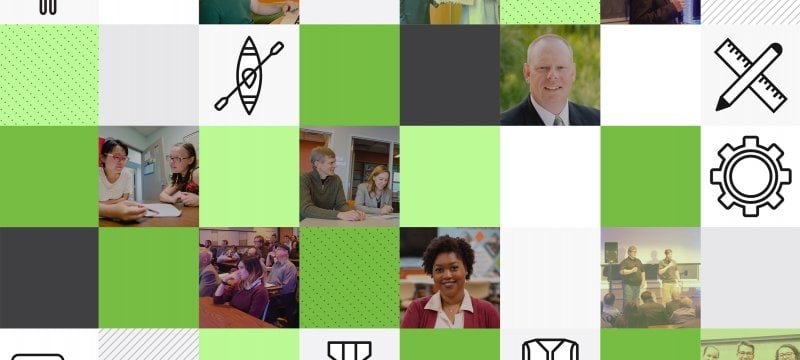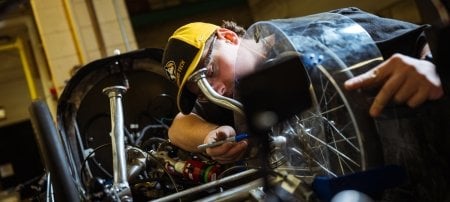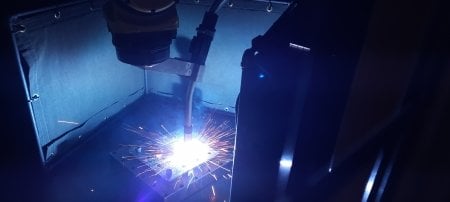Promoting a mindset that favors nimble thinking through human-centered problem solving.
Heated life jackets. Autonomous vehicles rugged enough for unstructured environments. These Michigan Tech-engineered solutions are the result of design thinking. Some would argue that an engineering education teaches design; after all, engineers define, design, prototype, and test. But thinking like an engineer is often described as procedural, step by step, which can be limiting and fraught with error. Conversely, agile thinkers favor a recursive, iterative, or holistic approach to problem solving.
Using the concepts of design—considering user needs, brainstorming, prototyping, testing—Michigan Tech faculty, staff, administrators, and students are promoting a human-centered approach to problem solving that unleashes creative potential and results in superior solutions.
"Our students are going to be much more valuable as employees if they are innovative—if they are coming up with new ideas, new technologies that create value for the companies they work for. That’s one of the reasons why we’re promoting design thinking,” says Mary Raber, assistant dean of the Pavlis Honors College. Raber is also co-director of the Innovation Center for Entrepreneurship, along with Jim Baker, associate vice president for research administration, and Jonathan Leinonen, lecturer in management.
Raber has played a critical role in bringing design thinking to campus, working behind the scenes with Baker for more than a decade “to incrementally encourage students’ and faculty’s ability to innovate and create,” she says.
Design thinking is a five-phase problem-solving approach: empathize, define, ideate, prototype, and test. But it’s not a linear process; it’s circular and messy. Most importantly, it puts people first, which is why empathy is its basis.
Cameron Philo, a junior studying electrical engineering, used design thinking to create his startup, Life Pro Jackets. Philo was moved by a story about a family’s fatal kayaking trip:
“A family of four went kayaking on Lake Superior and their boats tipped. Only the mom came back because the water was so cold. When I heard the story, I thought, ‘They were doing everything right, they were wearing life jackets, but it still wasn’t enough.’ It got me thinking: for people who are taking the right steps and precautions, how can we make sure it’s always safe for them to come back? So, I came up with a way to put some heating elements into a life jacket to prevent hypothermia and put GPS tracking into it so the wearer can trigger it and alert first responders.”
Philo’s ability to empathize with the story about the family kayaking trip inspired him to find a solution. Talking with first responders and water enthusiasts, and considering the contextual factors of water safety, helped him further define the problem—the second step of design thinking.
“We noticed there are a lot of bodies of water that don’t get very warm. The problem with that is people can quickly develop hypothermia,” Philo says, noting that first responders pointed out that when someone falls out of a boat on the water, the boat may float away from the person, making search and rescue more difficult. “That’s where the GPS comes in,” Philo says.
The next step is ideation. Philo worked with teammates and fellow undergraduate students Jacob Formolo (biomedical engineering) and Jared Harber (materials science and engineering) to share and build on their ideas. They thought about how to heat the life jacket safely, considering the installation of either chemical or electrical heating elements as well as manual or automatic triggering of GPS with water or temperature-pressure sensors.

Cameron Gears Up for New Venture—Part 1

Cameron Gears Up for New Venture—Part 2

Cameron Gears Up for New Venture—Part 3
After ideation, Philo says he studied Coast Guard data to calculate water temperatures and lengths of time someone could safely stay in the water.
Philo then demonstrated his idea for its intended user and received feedback to improve the designs—and he did this over and over. He participated in several on-campus activities and in a local effort, “1 Million Cups,” where he pitched his idea to diverse audiences for feedback and suggested resources.
The result? A transformation of the traditional life jacket into a wearable technology that provides more safety without requiring the user to, as Philo puts it, “wear a ton of stuff.”
At the April 12, 2019, New Venture Competition at Central Michigan University, Philo’s Life Pro Jacket won $10,000 for Best Technology Venture.
Making the Agile Thinker
In 2004, David Kelley, founder of the Stanford School of Design (known today as the Hasso Plattner Institute of Design or d.school) introduced the five phases of design thinking. When the concept took off—classes at Stanford were (and continue to be) packed, spurring interviews on 60 Minutes and bestselling books—two d.school educators, Bill Burnett and Dave Evans, co-opted design thinking to create “life design.” Life design helps students take ownership of their life journey by applying five mindsets—curiosity, bias to action, reframing, awareness, and radical collaboration.
"Design thinking equips students with the skills and competencies to be successful in the rapidly changing economic environment of the future."
These five mindsets form the foundation of Design Your Life courses taught in various programs across campus. For instance, Melissa Michaelson ’16, coordinator of career development programming and a career advisor in Career Services, teaches Design Your Career workshops where students learn and apply the five mindsets on activities like Odyssey Plan, which asks participants to create three alternative versions of their five-year plan. Each plan must include a combination of graphics, a visual dashboard, a six-word title, and three questions the plan poses (for example, Do I have what it takes?).
Michaelson says the multiple-week, interactive workshops “can be an effective resource for students still trying to figure out what they want out of their education at Tech, so that they can live a meaningful and fulfilling life after graduation.”
Lisa Casper, program manager of the Innovation Center for Entrepreneurship, says that design thinking workshops are a key part of Husky Innovate—a new yearly series of co-curricular workshops and competitions that encourage students to identify problems as opportunities and work with teams to innovate solutions.
Casper says the workshops “empower students with the ability to adapt to changing environments and to make a positive impact where solutions are needed.”
Casper arrived on campus last summer, with both industry and academic experience, to help students prepare for events like the New Venture Competition, the grand finale of the Husky Innovate series, where Michigan Tech students like Philo have taken home big prize money for their budding business ideas.
Design thinking also plays an integral role in the Pavlis Honors College. Lorelle Meadows, the College’s dean, says design thinking “penetrates everything we do at Pavlis; it’s a core strategy we employ. We use it in our classes and as a program when we’re developing new ideas.”
According to Meadows, design thinking is an important toolkit for students: “It introduces them to the idea that they need to question things, challenge assumptions, and address uncertainty. It’s an important set of skills and mindsets to prepare students to address the kind of accelerated change that they will encounter in the world after graduation.”
Student Innovation
Michigan Tech is one of more than 250 higher education institutions around the globe participating in the University Innovation Fellows program. After six weeks of training in design thinking, Fellows apply the design-thinking principles through a specific project to benefit their campus community. To date, the program has trained 18 Huskies to think and act like designers.
"Huskies have a scrappiness. It's inherently a part of our culture and it winds up being an asset. No matter what you're trying to do, your fundamental struggle is with resource constraints—whether that's time, money, people, natural resources. Michigan Tech stands out by giving students the skills to be successful, using their scrappiness in a resource-lean environment to achieve their goals."
Michigan Tech’s Fellows helped to transform the old bowling alley in the basement of the Memorial Union Building into The Alley Makerspace. Now, Fellows help run an open community workshop in The Alley, showing students, faculty, and staff how to create things like sample prototypes.

The Alley Makerspace
Fellow Magann Dykema ’19 taught design thinking to elementary students by asking them to think of a problem they see in everyday life, like a heavy backpack or leaky water bottle. Once students explored some problems by empathizing and defining, they worked to develop innovative solutions, even building simple prototypes with supplies like pipe cleaners and playdough so they could test their ideas with real users.
Dykema knows her students will benefit from being exposed to design thinking at an early age. “The mindset has been very valuable for me at Michigan Tech,” she says. “It encourages unique problem solving, which allows you to challenge and question things—to try new things that haven’t been done before.”

My Michigan Tech: Magann Dykema
From Idea to I-Corps
Michigan Tech is one of 100 designated National Science Foundation (NSF) Innovation Corps (I-Corps) sites in the country. The I-Corps curriculum provides an entrepreneurial program for graduate and undergraduate students, faculty, staff, alumni, and community teams to transition innovative business solutions into viable, marketable products. The program is based on what’s known as “lean startup” principles, which, much like design thinking, favor iterative design and customer feedback.
Michigan Tech’s I-Corps program pushes faculty and students to think about commercialization from a human-centered approach—taking teams outside the lab or classroom to test their ideas over four weeks and in at least 30 face-to-face interviews with potential customers and partners from teams’ proposed target markets.
Professor of Chemical Engineering and Dean of the College of Computing Adrienne Minerick ’98, then-post-doctoral researcher Kaela Leonard ’12, and Raber won first place among 21 teams for their medical micro-device: a quick, portable blood-typing technology they developed during their I-Corps involvement in 2013. This led to follow-on funding through one of NSF’s small business technology transfer programs.
Andrew Barnard ’02 ’04, director of the Great Lakes Research Center, and Amlan Mukherjee, associate professor of civil and environmental engineering, are two of several faculty who have completed the I-Corps program. Their involvement not only led to starting their own businesses, but it also revamped the way they teach their classes. Barnard and Mukherjee, along with other faculty, help to teach fellow University professors how to incorporate the lean startup and design-thinking processes into their classes and research.
Mukherjee says a design-thinking mindset “changes your approach to everything you do. You start looking at the world from a problem-solving approach. Once you identify the client’s needs, the math is the easy part, but being able to do the right math for the right project—that’s where the design-thinking mindset comes in. Are you solving a problem that matters, and are you creating value out of it? Creating value in the process of problem solving is the part of the design-thinking mindset that has really affected me.”
To further promote the entrepreneurial, design-thinking mindset Mukherjee describes, Michigan Tech recently became a partner of the Kern Family Foundation’s Kern Entrepreneurial Engineering Network (KEEN). KEEN partners are higher education institutions committed to instilling the entrepreneurial mindset in their engineering students. Raber says Michigan Tech’s program will be geared toward undergraduates.
Whether it’s creating value or a novel solution, design thinking is more than a fancy phrase. By taking a human-centered approach, design thinking not only changes mindsets. As evidenced by Cameron Philo’s Life Pro Jackets, it can even save lives.
Michigan Technological University is an R1 public research university founded in 1885 in Houghton, and is home to nearly 7,500 students from more than 60 countries around the world. Consistently ranked among the best universities in the country for return on investment, Michigan's flagship technological university offers more than 185 undergraduate and graduate degree programs in science and technology, engineering, computing, forestry, business, health professions, humanities, mathematics, social sciences, and the arts. The rural campus is situated just miles from Lake Superior in Michigan's Upper Peninsula, offering year-round opportunities for outdoor adventure.






